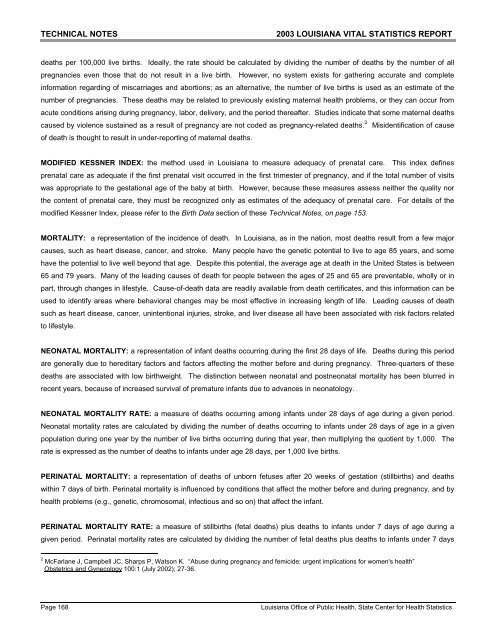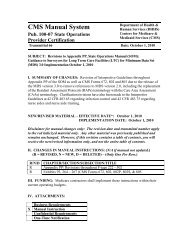2003 Louisiana Vital Statistics Report - Louisiana Department of ...
2003 Louisiana Vital Statistics Report - Louisiana Department of ...
2003 Louisiana Vital Statistics Report - Louisiana Department of ...
Create successful ePaper yourself
Turn your PDF publications into a flip-book with our unique Google optimized e-Paper software.
TECHNICAL NOTES <strong>2003</strong> LOUISIANA VITAL STATISTICS REPORT<br />
deaths per 100,000 live births. Ideally, the rate should be calculated by dividing the number <strong>of</strong> deaths by the number <strong>of</strong> all<br />
pregnancies even those that do not result in a live birth. However, no system exists for gathering accurate and complete<br />
information regarding <strong>of</strong> miscarriages and abortions; as an alternative, the number <strong>of</strong> live births is used as an estimate <strong>of</strong> the<br />
number <strong>of</strong> pregnancies. These deaths may be related to previously existing maternal health problems, or they can occur from<br />
acute conditions arising during pregnancy, labor, delivery, and the period thereafter. Studies indicate that some maternal deaths<br />
caused by violence sustained as a result <strong>of</strong> pregnancy are not coded as pregnancy-related deaths. 2 Misidentification <strong>of</strong> cause<br />
<strong>of</strong> death is thought to result in under-reporting <strong>of</strong> maternal deaths.<br />
MODIFIED KESSNER INDEX: the method used in <strong>Louisiana</strong> to measure adequacy <strong>of</strong> prenatal care. This index defines<br />
prenatal care as adequate if the first prenatal visit occurred in the first trimester <strong>of</strong> pregnancy, and if the total number <strong>of</strong> visits<br />
was appropriate to the gestational age <strong>of</strong> the baby at birth. However, because these measures assess neither the quality nor<br />
the content <strong>of</strong> prenatal care, they must be recognized only as estimates <strong>of</strong> the adequacy <strong>of</strong> prenatal care. For details <strong>of</strong> the<br />
modified Kessner Index, please refer to the Birth Data section <strong>of</strong> these Technical Notes, on page 153.<br />
MORTALITY: a representation <strong>of</strong> the incidence <strong>of</strong> death. In <strong>Louisiana</strong>, as in the nation, most deaths result from a few major<br />
causes, such as heart disease, cancer, and stroke. Many people have the genetic potential to live to age 85 years, and some<br />
have the potential to live well beyond that age. Despite this potential, the average age at death in the United States is between<br />
65 and 79 years. Many <strong>of</strong> the leading causes <strong>of</strong> death for people between the ages <strong>of</strong> 25 and 65 are preventable, wholly or in<br />
part, through changes in lifestyle. Cause-<strong>of</strong>-death data are readily available from death certificates, and this information can be<br />
used to identify areas where behavioral changes may be most effective in increasing length <strong>of</strong> life. Leading causes <strong>of</strong> death<br />
such as heart disease, cancer, unintentional injuries, stroke, and liver disease all have been associated with risk factors related<br />
to lifestyle.<br />
NEONATAL MORTALITY: a representation <strong>of</strong> infant deaths occurring during the first 28 days <strong>of</strong> life. Deaths during this period<br />
are generally due to hereditary factors and factors affecting the mother before and during pregnancy. Three-quarters <strong>of</strong> these<br />
deaths are associated with low birthweight. The distinction between neonatal and postneonatal mortality has been blurred in<br />
recent years, because <strong>of</strong> increased survival <strong>of</strong> premature infants due to advances in neonatology.<br />
NEONATAL MORTALITY RATE: a measure <strong>of</strong> deaths occurring among infants under 28 days <strong>of</strong> age during a given period.<br />
Neonatal mortality rates are calculated by dividing the number <strong>of</strong> deaths occurring to infants under 28 days <strong>of</strong> age in a given<br />
population during one year by the number <strong>of</strong> live births occurring during that year, then multiplying the quotient by 1,000. The<br />
rate is expressed as the number <strong>of</strong> deaths to infants under age 28 days, per 1,000 live births.<br />
PERINATAL MORTALITY: a representation <strong>of</strong> deaths <strong>of</strong> unborn fetuses after 20 weeks <strong>of</strong> gestation (stillbirths) and deaths<br />
within 7 days <strong>of</strong> birth. Perinatal mortality is influenced by conditions that affect the mother before and during pregnancy, and by<br />
health problems (e.g., genetic, chromosomal, infectious and so on) that affect the infant.<br />
PERINATAL MORTALITY RATE: a measure <strong>of</strong> stillbirths (fetal deaths) plus deaths to infants under 7 days <strong>of</strong> age during a<br />
given period. Perinatal mortality rates are calculated by dividing the number <strong>of</strong> fetal deaths plus deaths to infants under 7 days<br />
2<br />
McFarlane J, Campbell JC, Sharps P, Watson K. “Abuse during pregnancy and femicide: urgent implications for women's health”<br />
Obstetrics and Gynecology 100:1 (July 2002); 27-36.<br />
Page 168 <strong>Louisiana</strong> Office <strong>of</strong> Public Health, State Center for Health <strong>Statistics</strong>
















